Body clock science explains why women and men sleep differently
“This touches on a broader problem in biomedical research."

The circadian rhythm, also known as the body clock, keeps most living things in time with the passing of the 24-hour day-night cycle: Animals, plants, and microbes are all regulated by this system.
But individual differences are becoming increasingly apparent — especially when it comes to the differences in body clock experienced by males and females.
In an article published Thursday in the journal Science, researchers argue that it’s time to put more resources into understanding this difference and the potential consequences it has on human health. Further study is especially needed in understanding how the circadian rhythm, and disruptions to it, influences practical elements of human life, including how we work, travel, and, of course, sleep.
Sean Anderson, a postdoctoral fellow at the University of Pennsylvania, co-wrote the perspective piece with Garret FitzGerald, a professor at the same university. Anderson tells Inverse that in the future, further study on the biological basis of this difference, or dimorphism, “will allow us to determine whether such medical interventions [like drug treatments that target the body clock] should differ between men and women.”
“This touches on a broader problem in biomedical research,” Anderson says. “It is important that we appreciate that experiments that only have been done with males may not translate exactly to females.”
The evidence so far — Anderson argues that while “there has been some great research done in this area,” so far, he and FitzGerald feel sleep is understudied.
One reason for that, Anderson says, is that the estrous cycle has a heavy influence on circadian rhythms. This is the main reproductive cycle of female species of non-primate vertebrates, animals like mice and pigs. This cycle can complicate experimental designs involving most animals, and make comparisons between men and women more difficult, he explains.
“This is particularly important given the 24-hour nature of our modern society."
But the research conducted so far on both humans and other animals shows compelling evidence of sexual dimorphism in circadian rhythms. For example, studies of hamsters living in constant darkness revealed that female hamster “core molecular clock machinery” oscillates faster than that of males. Research conducted in mice, meanwhile, found that genes governing body clock act differently across the sexes, and may protect female mice from heart disease.
Studies in humans indicate that the circadian rhythms of melatonin and body temperature are set to an earlier hour in women, compared to men. This manifests as men having a body clock that is about six minutes longer than women. While there are, of course, individual preferences, this difference is thought to explain why, on average, most men are “night owls,” while most women are “early birds.” More than 1 in 3 women, the authors of a 2011 paper say, have body clocks that complete a daily cycle in less than 24 hours.
For now, there is “no clear understanding” of the evolutionary reasons as to why men and women’s body clocks aren’t exactly the same, Anderson says.
“We have suggested that one possible reason for the earlier timing we see in women may have helped them historically to be more in sync with young children who are also morning-types,” he explains. “But this is something which is still up for debate.”
The effect of these differences — Scientists argue that these sex differences not only explain why women and men sleep differently, but why the sexes are at risk for different sleep conditions.
Women appear to need 20 more minutes of sleep than men. They’re also more likely to have less energy at night, which may explain why female shift-workers are at an increased risk of work-related injuries. Because women are more likely to wake up earlier, researchers also theorize they may be more susceptible to insomnia.
But women with higher-amplitude rhythms also perform the best on cognitive tests evaluating working memory, attention, effort, mood, and sleepiness. Having a high amplitude, or more distinction between high activity and low activity periods, its “typically beneficial,” Anderson says.
“It allows for greater separation of processes we don’t want to occur at the same time — if you are waking up and moving about a lot through the night, you will not feel well-rested in the morning,” he explains.
Overall, men are more negatively affected by sleep deprivation. Women are more resilient to body clock disruptions — challenges to a full night’s rest like travel across time zones or a late night working. More and more studies are detailing how men and women’s body clocks respond differently to these types of situations, Anderson says.
“This is particularly important given the 24-hour nature of our modern society,” he explains.
There’s a real need for more “prospective studies” on the topic, Anderson argues. Emergent technology like wearables can help, alongside new lab techniques used to understand the influence of hormones on the body clock. But it will also take well-controlled, longitudinal analyses of people — the sort of studies that could lead to better sleep for all.